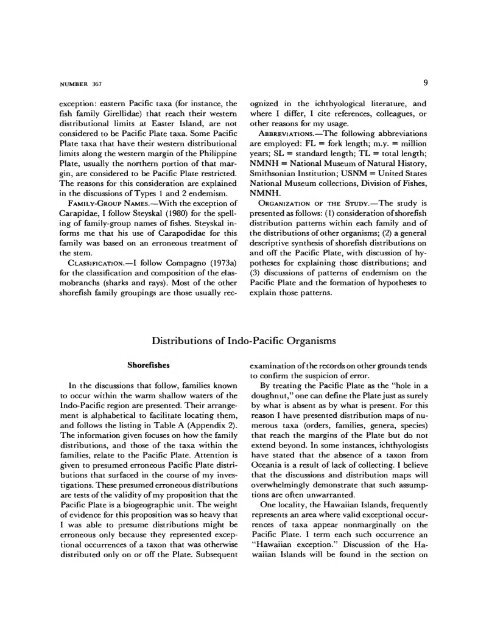Pacific Plate Biogeography, with Special Reference to Shorefishes
Pacific Plate Biogeography, with Special Reference to Shorefishes
Pacific Plate Biogeography, with Special Reference to Shorefishes
Create successful ePaper yourself
Turn your PDF publications into a flip-book with our unique Google optimized e-Paper software.
NUMBER 367<br />
exception: eastern <strong>Pacific</strong> taxa (for instance, the<br />
fish family Girellidae) that reach their western<br />
distributional limits at Easter Island, are not<br />
considered <strong>to</strong> be <strong>Pacific</strong> <strong>Plate</strong> taxa. Some <strong>Pacific</strong><br />
<strong>Plate</strong> taxa that have their western distributional<br />
limits along the western margin of the Philippine<br />
<strong>Plate</strong>, usually the northern portion of that margin,<br />
are considered <strong>to</strong> be <strong>Pacific</strong> <strong>Plate</strong> restricted.<br />
The reasons for this consideration are explained<br />
in the discussions of Types 1 and 2 endemism.<br />
FAMILY-GROUP NAMES.—With the exception of<br />
Carapidae, I follow Steyskal (1980) for the spelling<br />
of family-group names of fishes. Steyskal informs<br />
me that his use of Carapodidae for this<br />
family was based on an erroneous treatment of<br />
the stem.<br />
CLASSIFICATION.—I follow Compagno (1973a)<br />
for the classification and composition of the elasmobranchs<br />
(sharks and rays). Most of the other<br />
shorefish family groupings are those usually rec-<br />
<strong>Shorefishes</strong><br />
In the discussions that follow, families known<br />
<strong>to</strong> occur <strong>with</strong>in the warm shallow waters of the<br />
Indo-<strong>Pacific</strong> region are presented. Their arrangement<br />
is alphabetical <strong>to</strong> facilitate locating them,<br />
and follows the listing in Table A (Appendix 2).<br />
The information given focuses on how the family<br />
distributions, and those of the taxa <strong>with</strong>in the<br />
families, relate <strong>to</strong> the <strong>Pacific</strong> <strong>Plate</strong>. Attention is<br />
given <strong>to</strong> presumed erroneous <strong>Pacific</strong> <strong>Plate</strong> distributions<br />
that surfaced in the course of my investigations.<br />
These presumed erroneous distributions<br />
are tests of the validity of my proposition that the<br />
<strong>Pacific</strong> <strong>Plate</strong> is a biogeographic unit. The weight<br />
of evidence for this proposition was so heavy that<br />
I was able <strong>to</strong> presume distributions might be<br />
erroneous only because they represented exceptional<br />
occurrences of a taxon that was otherwise<br />
distributed only on or off the <strong>Plate</strong>. Subsequent<br />
Distributions of Indo-<strong>Pacific</strong> Organisms<br />
ognized in the ichthyological literature, and<br />
where I differ, I cite references, colleagues, or<br />
other reasons for my usage.<br />
ABBREVIATIONS.—The following abbreviations<br />
are employed: FL = fork length; m.y. = million<br />
years; SL = standard length; TL = <strong>to</strong>tal length;<br />
NMNH = National Museum of Natural His<strong>to</strong>ry,<br />
Smithsonian Institution; USNM = United States<br />
National Museum collections, Division of Fishes,<br />
NMNH.<br />
ORGANIZATION OF THE STUDY.—The study is<br />
presented as follows: (1) consideration of shorefish<br />
distribution patterns <strong>with</strong>in each family and of<br />
the distributions of other organisms; (2) a general<br />
descriptive synthesis of shorefish distributions on<br />
and off the <strong>Pacific</strong> <strong>Plate</strong>, <strong>with</strong> discussion of hypotheses<br />
for explaining those distributions; and<br />
(3) discussions of patterns of endemism on the<br />
<strong>Pacific</strong> <strong>Plate</strong> and the formation of hypotheses <strong>to</strong><br />
explain those patterns.<br />
examination of the records on other grounds tends<br />
<strong>to</strong> confirm the suspicion of error.<br />
By treating the <strong>Pacific</strong> <strong>Plate</strong> as the "hole in a<br />
doughnut," one can define the <strong>Plate</strong> just as surely<br />
by what is absent as by what is present. For this<br />
reason I have presented distribution maps of numerous<br />
taxa (orders, families, genera, species)<br />
that reach the margins of the <strong>Plate</strong> but do not<br />
extend beyond. In some instances, ichthyologists<br />
have stated that the absence of a taxon from<br />
Oceania is a result of lack of collecting. I believe<br />
that the discussions and distribution maps will<br />
overwhelmingly demonstrate that such assumptions<br />
are often unwarranted.<br />
One locality, the Hawaiian Islands, frequently<br />
represents an area where valid exceptional occurrences<br />
of taxa appear nonmarginally on the<br />
<strong>Pacific</strong> <strong>Plate</strong>. I term each such occurrence an<br />
"Hawaiian exception." Discussion of the Hawaiian<br />
Islands will be found in the section on

















